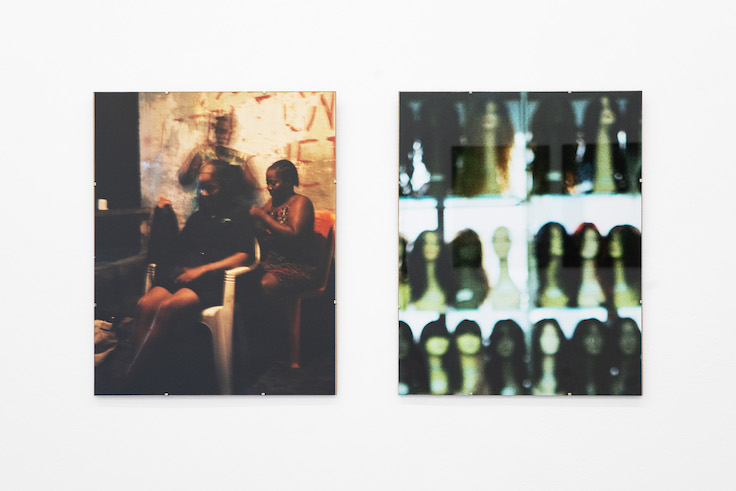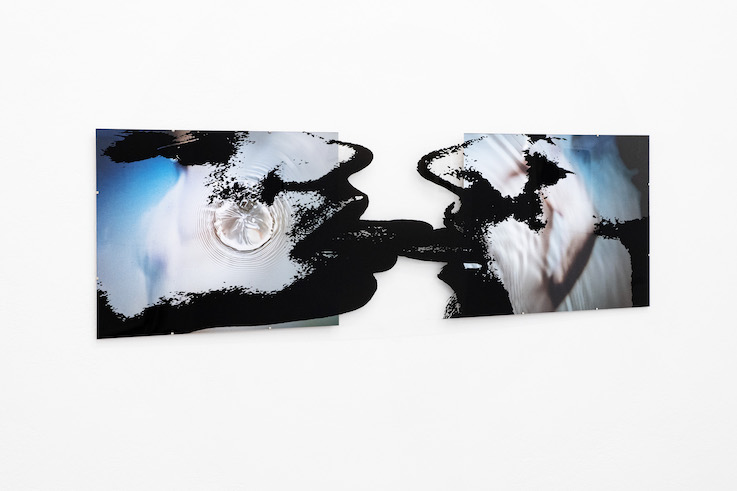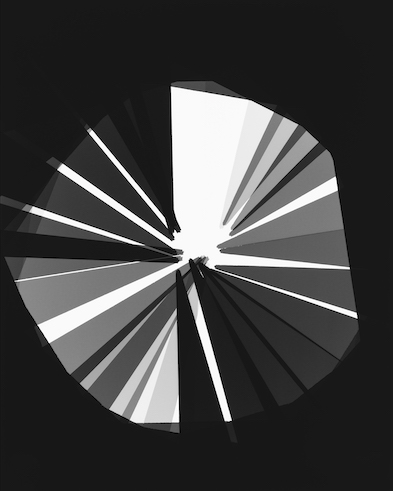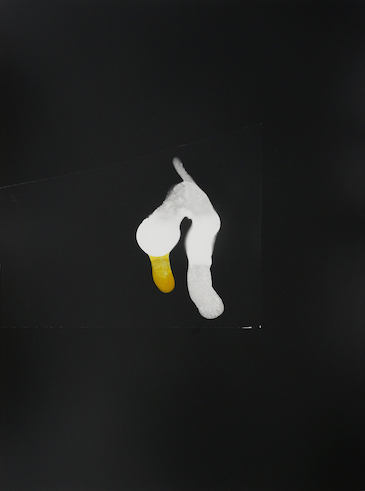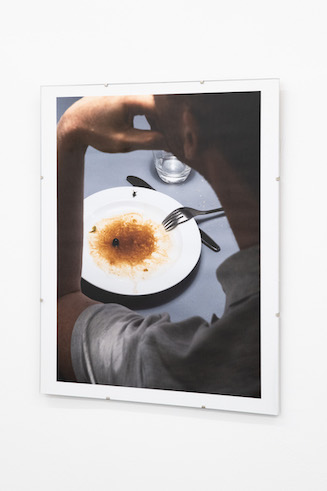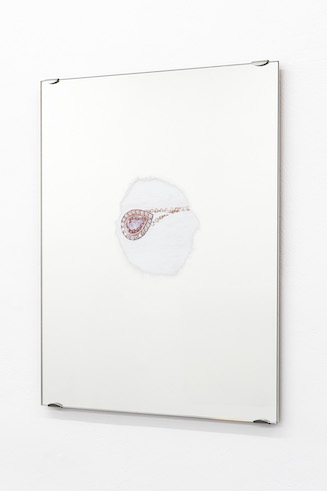Press information
Destroying Photography
Infos
Press preview
6.12.2024, 11 a.m.
Opening
6.12.2024, 6 p.m.
Exhibition talk
with Wolfgang Ullrich
4.2.2025, 6 p.m.
Duration
6.12.2024 – 9.2.2025
Opening hours
Tue – Sun and bank holidays
10 a.m. – 6 p.m.
With works by
Laurel Chokoago, Elisa Goldammer, Maik Gräf, Almut Hilf, Maximilian Koppernock, Mitko Mitkov, Sophie Pölzl, Claudia Rohrauer, Caspar Sänger, Jenny Schäfer, Janine Schranz, Wiebke Schwarzhans, Dirk Stewen, Daniela Zeilinger and a text by Mira Anneli Naß.
Idea & Concept
The project was initiated in Hamburg by Maik Gräf and Jenny Schäfer, and then further developed by Daniela Zeilinger for Camera Austria.
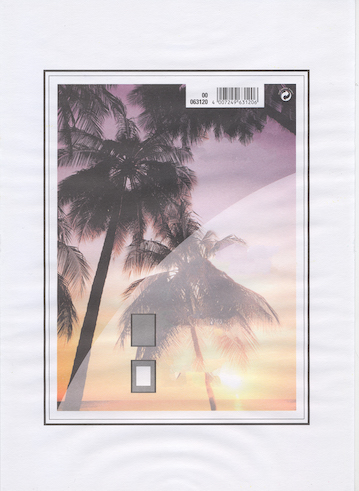
Press Information
In Ruins
The desire to destroy photography in an era as addicted to pictures as ours seems paradoxical. In light of the steady triumphal procession of the mass media of photography and film, the French poet Paul Valéry already prophesized in 1928: “just as water, gas, and electricity,” pictures would soon, be brought into our homes, “appear[ing] and disappear[ing] at a simple movement of the hand”1; and, today, we are indeed being confronted every day with more photographs than lie dormant in the family albums of entire generations, determining discourses and debates to a greater extent than the written word, undergirding, indeed producing ostensible knowledge, and transcending society as if having a life of their own. Yes, of course, the relevance of photographic images today is being gnawed at, abraded, scratched, and shaken up across the board: Increasingly simpler and faster possibilities for manipulating pictures have eroded trust in their status as mediators of reality, of Roland Barthes’s “that has been,” while the image generators of allegedly artificial intelligences extend their unshapely hands in all directions and threaten to supersede and outpace the lens. And yet, today as well, an aura of truth and veracity still clings to photography, a strange, almost magical suggestive power that one is unable to escape and continues to shape our world further. In spite of everything, Roland Barthes’s old observation regarding photography’s potential to capture the “real, in its indefatigable expression”2 can still be regarded as apt.
Under the pressure of this flood, artistic photography, however, seems to be bogged down in a crisis, in constantly playing catch up, in a peculiar balancing act between utility and artistic value, reportage and concept, reproduction and creativity. Even 185 years after it was invented by Louis Daguerre, it is viewed by parts of the art establishment as an alien body. Ninety years after Walter Benjamin’s essay “The Work of Art in the Age of Its Technological Reproducibility,” it is also torn (also under economic pressure) between handprinted works, NFTs, and social media feeds, and wrestles with expectations of the medium. Not only its own technical limitations (“The photographer has to will what the camera can do,”3 is an oft-cited saying by Vilém Flusser), but especially its own history too weighs heavily on it, which is why it is also undermined on a theoretical and political level by numerous discourses, and is confronted by questions that indicate an increasing problem with the medium. The gaze of the lens has thus long since been regarded as anything but innocent, since it is linked to exploitative dependencies as toxic as photochemical processes; the camera has been convicted as a complicit tool of oppression and voyeurism. “The view of reality as an exotic prize to be tracked down and captured by the diligent hunter-with-a-camera has informed photography from the beginning . . .,”4 as Susan Sontag, for instance, writes—whereby she already attests to the early photographic activities of a nascent “class tourism.” Under such premises, “Destroying Photography” becomes understandable as a title that takes up this problem, this frustration, in order to pruriently invoke a sort of end to such a biased medium (whereby the gimmicky slogan also parodies the destructive logic of social media and yet seems to serve it at the same time). But specifically in a phase of decline, the conditions, expectations, and conventions of the medium have to be negotiated anew. Jenny Schäfer and Maik Gräf brought together the majority of the altogether fourteen positions, which can be regarded as a sort of shifting of perspectives in the field, under the aforementioned title for the first time in early 2024 for the FRISE Künstler*innenhaus Hamburg; on the initiative of Daniela Zeilinger, the exhibition, expanded to include Austrian positions, can now be seen in Graz. In it, the works are framed by a curatorial twist: Each participant is given just two picture holders in a forty-by-fifty-centimeter format—an ironic turn, as a formal allusion to a wall of pictures in a home, to the ultimate dwarfing of the medium into living room decoration.
Those who already saw the version of the exhibition in Hamburg will notice that the approaches to this topic are as manifold as the number of positions, but that the photo camera is barely deployed in the classic manner. Pictures found or one’s own are pruriently cut up, dissected, arranged anew, and collaged, like the logical progression of the spirit of the age: Producing new pictures when everything has already been recorded, documented, and depicted seems to make little sense. And if every picture can be copied and altered endlessly, the remix is ultimately already a productive preemption of the inevitable chopping-up of every production of images. While Dirk Stewen creates connecting windows between pictures of everyday life with his precisely perforated pictures, Almut Hilf’s collages are barely readable as photographs when she cuts prints of architecture photos into pieces and reassembles the individual elements through diligent analogue work in such a way that the often-complex geometrical pictures call to mind more Cubist experiments in perception or digital image interference. Jenny Schäfer herself also processes the world in her own form of collages. In compilations of pictures that are in part overflowing, in part positioned in a precise-minimalist manner without any regard for their origins from high-, popular culture or her private archive, she makes meta-assertions about the world of symbols and our fascination with what draws our gaze, whereby she touches again and again on questions of taste and class.
Fragments and ruins: In an exhibition that bears the term destroy in its title, it is not surprising that broken pieces in numerous literal senses play a leading role. It is a disassembling of photographic processes, a parsing-into-individual-elements, a laying open-to-analysis, or a continuous expansion, whereby the means selected range from a precise, methodical dissecting of their underlying assumptions to the physical act of deconstructing. Maik Gräf, for instance starts, quite literally, from fragile material when he frequently takes fragmented statues from Greek antiquity as the starting point for his photographic works on identity and sexuality, whereby, for him, the sensitive photo paper mirrors the vulnerability of human skin. This is intensified further when, in the exhibition, he positions a text fragment by Didier Eribon above the cut-up pictures of male bodies and thus correlates the friable surfaces with inner turmoil. Sophie Pölzl addresses the starting material of each photograph in a different way: The daylight in various spaces captured on photo paper in her work becomes a cartography of specific places and timespans, becomes a condensing of reality in photograms, hence unmanipulable, unique specimens: Information saved forever that—in an absurd twist—without background knowledge or labeling, will never be readable. Mitko Mitkov’s process-oriented approach also takes the storage of information to the absurd when he transfers photographs taken at random with a mobile telephone to the medium of lithography and thus produces a copy of a copy—a paradoxical, laborious task in which the protracted cutting-away, the painstaking preparation of the stone, the slow process in the medium of the nineteenth century merely in order to print a banal snapshot seems as far removed from the digital trigger click of a photography app as it can be, even though lithography is a direct predecessor of photography in its function as the first truly mass medium. Whereby, even here—as in the case of so many contributions in the exhibition—the concrete photo seems to play barely any role at all: It is merely material, which as a result of the loss of information from copy to copy becomes ever more indecipherable.
Disperse, translate, transfer: It thus becomes clear that we are moving here in the debris field of the exhibition as if in the ruins of a medium, losing ourselves in the undergrowth, on winding, overgrown paths, in an archeological digging in mounds, in remnants of them, where a new kind of photography can arise from the means and methods of the medium. Perhaps a sort that finally ruptures the bridges to reality, that is able to transcend “reality as an exotic prize” and to direct the gaze to other things—where discourses inherent in the medium can play a leading role just as much as the profoundly personal. Even such contributions to the exhibition that use the camera in a classic manner thus stretch the elastic band to the real world to the breaking point: For instance, in the work of Caspar Sänger, whose quiet, often-deserted pictures resemble random observations, but at second glance show displacements, strange occurrences barely suited to the casual language of photography. His picture puzzles are assembled from gestures, situations, fleeting phenomena that he finds in pictures from everyday life, from product to crime scene photos, but restaged precisely, cropped, recombined in the studio in a way that makes viewers doubt their own senses. The play with the limited information, the fragments of information there reflect the splintered nature of other contributions, hence seem to circle around a similar empty space. Perhaps also around those for whom photography no longer suffices to understand the world, also because reality itself can no longer be grasped.
Quite literally breaking pictures’ power of suggestion in order to confront them, to expose one’s own doubts, one’s own fragility: In the end, this is perhaps the “destroying of photography” that is meant here. But yet another, second aspect that seems relevant in connection to photography inheres in the ruins, in the fragment in itself. “The ideas ruins evoke in me are grand. Everything comes to nothing, everything perishes, everything passes . . .,”5 writes Denis Diderot on the aesthetic of the fragile in the eighteenth century—and expresses the notion of the fleeting, which has been closely linked to the essence of photography from the very beginning. Ultimately, its capturing of time has always been a sort of anticipation of death, as Mira Anneli Naß also paraphrases Roland Barthes in one of the programmatic texts hung in the exhibition. Destroying photography—against this backdrop, this seems to be but a hopeless task. Even if we no longer exist, our pictures remain behind. Whether they also reproduce us and our world accurately is another matter.
Raphael Dillhof
1 Paul Valéry, “The Conquest of Ubiquity,” as cited after Walter Benjamin, “The Work of Art in the Age of Its Technological Reproducibility” (1936), in Walter Benjamin: Illuminations. Essays and Reflections, ed. Hannah Arendt, trans. Harry Zohn (New York: Schocken Books, 1969), pp. 217–52, esp. p. 219.
2 Roland Barthes, Camera Lucida: Reflections on Photography, trans. Richard Howard (New York: Hill and Wang, 1981), p. 4.
3 Vilém Flusser, Towards a Philosophy of Photography, trans. Anthony Mathews (London: Reaktion Books, 2000), p. 35.
4 Susan Sontag, On Photography (New York: Picador, 1973), p. 50.
5 Denis Diderot, Diderot on Art, vol. II: The Salon of 1767, ed. Thomas Crow, trans. John Goodman (Newhaven, CT: Yale University Press, 1995), p. 198.
Images
Publication is permitted exclusively in the context of announcements and reviews related to the exhibition and publication. Please avoid any cropping of the images. Credits to be downloaded from the corresponding link.

